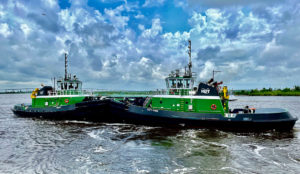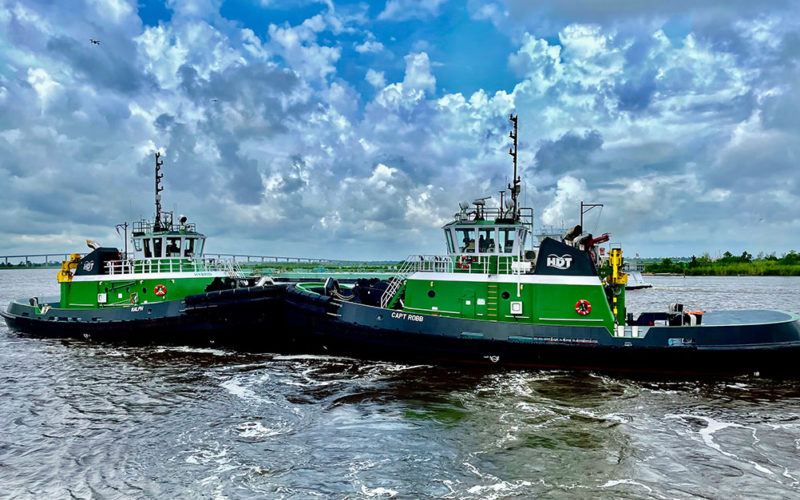
It’s been more than two years since Harbor Docking & Towing Co. added its first diesel-electric hybrid tugboats. That decision has paid off in multiple ways for the Lake Charles, La., operator.
The Caterpillar hybrid system aboard Ralph and Capt. Robb delivers 91.5 tons of bollard pull while offering flexibility from different propulsion settings. The system is fully optimized for Harbor Docking’s operational profile and has led to significant savings on fuel, maintenance and emissions, according to Harbor Docking President John Buchanan.
“You can really dial it in for your operation, and from a management side that is fantastic,” Buchanan said last summer during an interview aboard Ralph in Lake Charles.
“It is very unlikely we will ever build a regular ASD tractor tug again, just because of the cost savings,” he added.
The 93-foot Ralph and Capt. Robb were built in Maine by Washburn & Doughty. They were the first-ever U.S. vessels with an all-Caterpillar diesel-electric propulsion system. It consists of two 2,550-hp Cat 3512 mains, two 600-kW Cat C18 gensets and a 200-kW Cat C7.1 harbor genset, along with Cat z-drives. Two 750-hp ABB electric motors can power the drives on their own or in tandem with the main engines.
Ralph and Capt. Robb were two of the four hybrid tugboats delivered in mid-2019. The 100-foot Delta Teresa, built for Baydelta Maritime, and the 65-foot Michigan, built for Great Lakes Towing Co., round out the pack.
Delta Teresa has two 2,650-hp Caterpillar 3516 main engines, along with two 300-kW Cat C9.3 gensets and a 150-kW C7.1 genset, which supply electricity to 650-hp Marelli electric motors. The vessel, now operating in Los Angeles-Long Beach, can hit 90 tons of bollard pull at full system power.
Michigan, and its subsequent sister vessels in the series, are equipped with two 1,000-hp MTU main engines, twin 99-kW John Deere/Marathon diesel gensets and a Logan Clutch FlexaDrive system. Electricity from the gensets runs 75-hp electric motors installed on the Twin Disc reduction gears. The electric motors turn the gears, which turn the shafts to move the props.
Great Lakes Shipyard has delivered five tugs for sister company Great Lakes Towing since 2017, and the three most recent have the FlexaDrive hybrid propulsion. A sixth will be completed soon, and a seventh is slated for completion by mid-2022. Both will have the FlexaDrive system. The company has assigned its new tugs to major Great Lakes ports, where they have replaced older vessels.
“The tugs can make about 5 knots while underway with the hybrid system, which is generally used while operating to and from the job site and while standing by,” said Joe Starck, president of Great Lakes Towing Co. and Great Lakes Shipyard.
The maritime industry is rapidly moving toward a low-carbon or even zero-carbon future, with different fuels and battery technologies showing great promise as a replacement to traditional diesel engines. Those solutions, however, remain years away from broader adoption.
They also have price tags that many companies can’t afford or can’t justify. Crowley Maritime, for instance, received sizable subsidies for its proposed battery-electric tugboat eWolf, which will run almost entirely on electric power upon completion in 2023.
As such, hybrid tugboats offer something of a bridge between conventional diesel-propelled tugboats and low-carbon technologies of the future. Although they cost more to build, the additional investment needed for a hybrid tugboat can be recovered more quickly than with more advanced technology.
“The additional cost of the hybrid package was about $750,000 per tug, which was quite an undertaking,” Starck said. “But we estimate we will break even on the additional investment in about seven years. Thereafter, we expect the reduced operations and maintenance costs will make their way to our bottom line.”
Harbor Docking has experienced similar benefits from Ralph and Capt. Robb, which entered service in mid- and late-2019. Buchanan said fuel costs for its Lake Charles fleet fell by 48 percent in 2020, the first full year the hybrid vessels were in service. Additionally, the two vessels operated 47 percent of the time without the main engines, thereby reducing maintenance and extending the life of filters and other components that can cost $1,000 apiece or more.
Reduced emissions are another key element of the hybrid tugboats. Compared to a conventional tugboat, Ralph and Capt. Robb generate 20 percent less nitrogen oxides, 46 percent less carbon dioxide, 43 percent less hydrocarbon emissions and 78 percent less particulate matter, according to data from Harbor Docking.
“In my opinion, this is a game changer for companies trying to make meaningful emissions reductions within the port,” Buchanan said. “Anyone will be hard-pressed to build a tug that has better numbers while still offering 90 tons of bollard pull.”
Outwardly, Ralph and Capt. Robb resemble other 93-foot ASD tugboats designed by Washburn & Doughty. But their operation can differ substantially from a traditional z-drive tugboat. The propulsion system aboard both tugs has four customizable settings that control which engines, gensets and electric motors are used, and at what output. The two most commonly used are the “eco” mode and “power” mode, although the tugs have normal and FiFi settings, too.
Eco mode disengages the main engines and uses electricity from one or more generators to power the electric ABB motors. The tugs can hit 7.5 knots using a single C18 genset, and 10 knots using all three. The second and third generators automatically spool up as power demands exceed certain thresholds.
Captains use eco mode when transiting to and from jobs, loitering alongside a ship, or holding a vessel in position at the terminal. The electric motors, at full bore, can produce about 30 tons of bollard pull.
Power mode, meanwhile, is used during docking and assist, and while escorting big ships. It applies power from both main engines with additional boost from the electric motors using up to three generators. Together, in power mode, Ralph has reached 93 tons of bollard pull, according to Capt. Dion Kingsbury.
These modes and their underlying functionality have undergone multiple tweaks since the vessels arrived in Lake Charles. And that is a key benefit of the package, Buchanan said. By fine-tuning the engine settings, the company can maximize fuel savings.
“The beautiful thing about this boat is we can continue to adjust and fine-tune the programming to give us more power, less power, make it more economical or less economical — whatever we need to meet our needs operationally,” he said. “Right now, we have it pretty much dialed in.”
Even so, the company has found two tweaks it hopes will improve efficiency even further. Both changes would prevent the C7.1 harbor generator from automatically cycling on during eco and power modes. In both cases, that harbor unit kicks on for brief intervals during very short periods of high demand with minimal operational benefit.
Harbor Docking’s Lake Charles crews operate in some of the busiest petrochemical ports along the Gulf of Mexico. They routinely handle tankers and bulkers — and, increasingly, vessels loaded with wind turbine parts. The two hybrid tugboats have more than earned their keep, according to Kingsbury.
Ralph is “extremely responsive, and it can stop in its own length,” he said. “It’s maneuverable and the torque is there — there is no lag.”
The vessels are also smoother running, with less vibration than conventional tugs with similar horsepower, even when working a ship. And when necessary, the electric motors provide finesse at low rpms.
Kingsbury recalled waiting out a lightning storm last summer to undock a tanker from a nearby refinery. Ralph held the vessel against the terminal for more than three hours using power from a single genset.
“That would have been pumping NOx and CO2 and other bad stuff into the air if we were trying to run big diesel engines,” Buchanan added. “We’d have been idling at the least efficient speed possible. Instead, we were burning seven gallons an hour.”

